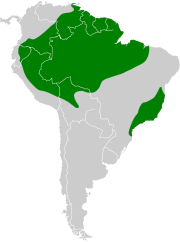Heliothryx
Genus of birds
| Heliothryx | |
|---|---|
 | |
| Purple-crowned fairy (Heliothryx barroti) | |
| Scientific classification | |
| Domain: | Eukaryota |
| Kingdom: | Animalia |
| Phylum: | Chordata |
| Class: | Aves |
| Clade: | Strisores |
| Order: | Apodiformes |
| Family: | Trochilidae |
| Subfamily: | Polytminae |
| Genus: | Heliothryx F. Boie, 1831 |
| Type species | |
| Trochilus auritus (black-eared fairy) Gmelin, JF, 1788 | |
| Species | |
| 2, see text | |
Heliothryx is a genus of hummingbird in the family Trochilidae. The genus is assigned to the subfamily Polytminae which is sometimes referred to by the informal name "mangoes".
Taxonomy
The genus Heliothryx was introduced in 1831 by the German zoologist Friedrich Boie.[1] Boie did not specify the type species but this was designated as the black-eared fairy by George Robert Gray in 1840.[2][3] The genus name combines the Ancient Greek hēlios meaning "sun" with thrix meaning "hair".[4]
The genus contains the following two species:[5]
| Common name | Scientific name and subspecies | Range | Size and ecology | IUCN status and estimated population |
|---|---|---|---|---|
| Black-eared fairy
| Heliothryx auritus (Gmelin, JF, 1788) Three subspecies | Bolivia, Brazil, Colombia, Ecuador, French Guiana, Guyana, Peru, Suriname, and Venezuela | Size: Habitat: Diet: | LC
|
| Purple-crowned fairy
| Heliothryx barroti (Bourcier, 1843) | southeastern Mexico south to southwestern Ecuador. | Size: Habitat: Diet: | LC
|
References
- ^ Boie, Friedrich (1831). "Bemerkungen über Species und einige ornithologische Familien und Sippen". Isis von Oken (in German). Cols 538–548 [547].
- ^ Gray, George Robert (1840). A List of the Genera of Birds : with an Indication of the Typical Species of Each Genus. London: R. and J.E. Taylor. p. 14.
- ^ Peters, James Lee, ed. (1945). Check-List of Birds of the World. Vol. 5. Cambridge, Massachusetts: Harvard University Press. p. 126.
- ^ Jobling, James A. (2010). The Helm Dictionary of Scientific Bird Names. London: Christopher Helm. p. 188. ISBN 978-1-4081-2501-4.
- ^ Gill, Frank; Donsker, David; Rasmussen, Pamela, eds. (January 2022). "Hummingbirds". IOC World Bird List Version 12.1. International Ornithologists' Union. Retrieved 11 July 2022.
- v
- t
- e
| |||||||||||||||||||||||||||||||||||||||||||||||||
| |||||||||||||||||||||||||||
Apodi | |||||||||||||||||
|---|---|---|---|---|---|---|---|---|---|---|---|---|---|---|---|---|---|
| |||||||||||||||||
 | This hummingbird-related article is a stub. You can help Wikipedia by expanding it. |
- v
- t
- e














